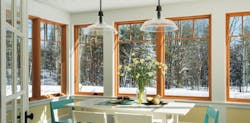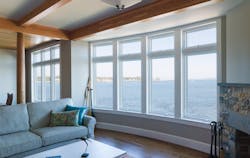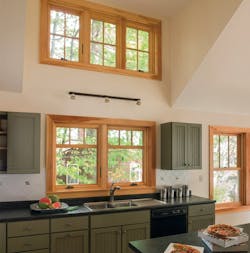How Windows Impact Home Design
Glass wraps around this breakfast nook (above), suffusing it with sunlight and offering views of the woods. All photos: courtesy Andersen Windows
Jay Libby, the creative-services manager at Andersen Windows, has 30 years of experience in product design and design research. Libby talked to DI about the latest developments in window design and technology, and offered a few tips about using windows to express specific architectural styles.
DI: What are some of the predominant trends you’re seeing in windows today?
JAY LIBBY: One trend we’re seeing is a strong surge in the popularity of modern architecture. The beauty of that is it starts breaking down the stereotype we might have had historically on the shape and role of the house. Much larger expanses of glass are being used, not necessarily everywhere in the house but in places where you really want to manage the view.
There is this notion of breaking down the boundaries between the indoors and outdoors so that it becomes more of a contiguous space. This actually dates back to Frank Lloyd Wright’s Prairie School houses, where he would bring the glass right up to the ceiling so that the wall would start disappearing visually. Given the insulation properties of windows today, you can design such walls of glass without compromising energy efficiency.
In certain parts of the country, sliding glass doors—10 feet or higher and either bifold or lift/slide doors—are often being used to erase the boundaries between the house and its outdoor living areas. A canopy of leaves can dissolve into the roof. A walk-out garden becomes part of the home itself.
Another trend I’m seeing, specifically in remodels, is something called house transformation, where a home is literally transformed from one architectural style into another. Windows play into that in a huge way. You might have a modern home and a Craftsman bungalow in the same neighborhood that are the same square footage and price, but for the people who live in those houses, it’s an entirely different lifestyle choice.
DI: American architecture is strongly regional, but there seems to be a trend of mixing two or more styles together. What do consumers need to know about window design when they’re building a new home or remodeling their current home?
LIBBY: A number of years ago, Andersen started researching trends in residential architecture across the United States. Regionalism has a lot to do with how this country was settled. Certain styles are very popular on the East Coast, which was settled by the English, whereas other styles are more popular in the South, which was settled by the French. Architectural styles in the West were influenced by Spanish settlers. Those influences are still there today.
Andersen researched the most popular styles to determine the correct massing, proportions, and materials. Then we created a series of pattern books that are now available to the trade and the public. The pattern books help consumers and housing professionals alike understand the role that windows play in achieving a desired style. The featured architectural styles include modern, Craftsman Bungalow, American Farmhouse, and Cape Cod, and can be downloaded here.
Interestingly, the number-one style in this country is what you alluded to: a blended style, which makes sense as long as the details, proportions, and scale are executed properly.
DI: Can you expand on the idea of managing the view?
LIBBY: A prominent architect once told me, “You need to figure out what time your house is.” What that means is that every home has a couple of special moments when the light comes in at a certain angle or a certain view is at its best. If the house is just a box with holes punched in it, you’re not going to get those moments. You have to think about how the room is going to be lived in, then manage the view to the outside.
A huge picture window or a perfectly aligned group of smaller windows can celebrate a home’s surroundings. Even when there’s no view, windows positioned high on the wall can still breathe light into a room. In a situation where the houses are right up against each other, putting windows up higher will give you a view of the trees and sky instead of your neighbor’s siding.
DI: How can windows be used to personalize a home and create memory points?
LIBBY: They can be used in the foyer, on a stairway, or on each side of a fireplace. You might want to bring in a bit of decorative glass as well. It was quite common in Arts & Crafts architecture—in the early 20th century when hand-built craftsmanship was celebrated—to have decorative glass in certain areas of the home where the light would hit it a certain way.
For instance, beveled glass refracts when it’s suffused by light. Art-glass panels can be used splash color inside or provide privacy. When sunlight hits the panels, it “fires” the glass and makes it come alive. Those spaces in your home become very endearing and memorable, to your point.
DI: Are there any other tips you’d like to share with readers?
LIBBY: Proper ventilation is more sophisticated than simply opening a window or two. Stacked ventilation, for example, utilizes roof windows in combination with wall windows, creating updrafts that funnel warm air outdoors and away from living areas. You can also use interior windows to channel fresh air to more remote locations.
Use windows in different shapes and combinations to create just the right look, either through recurring patterns or isolated statements that bring a rhythm to a home and help us connect with the space around us. Grille patterns can enhance traditional character or add a contemporary flair. Latches and handles that match the home’s décor provide finishing touches for beautiful window and door designs.


